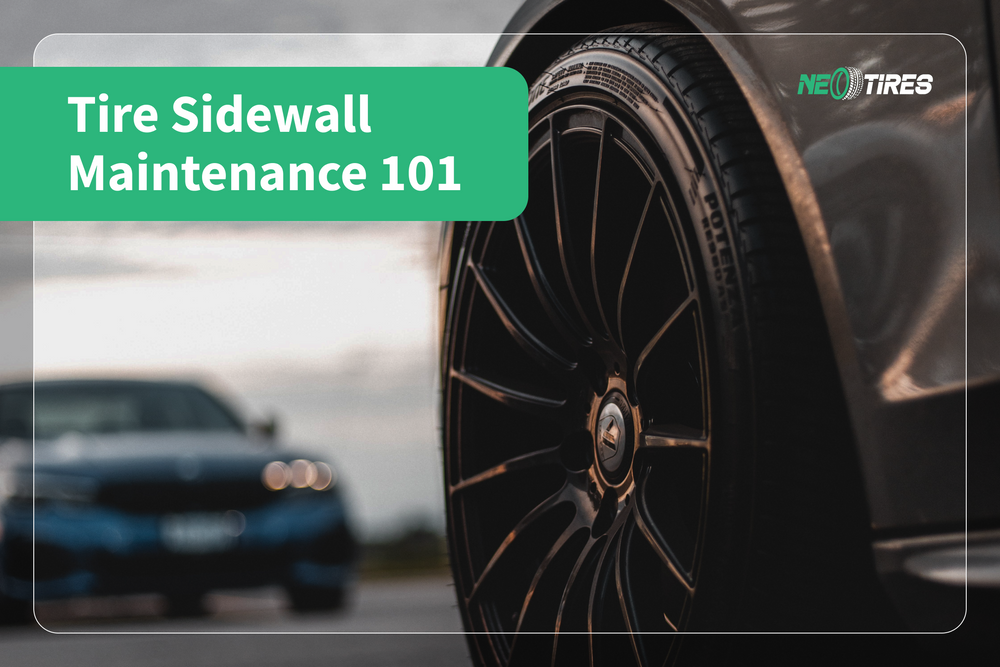If you were to ask a car enthusiast what is the most important component of a tire, he will probably tell you its tread. But the answer is only partially correct. In fact, each of the tire components plays an important role. And it is not necessary to know everything about them. It is enough to only keep in mind their purpose and specifics to choose the best ones. Thus, we can choose the correct tires for our car in a much more efficient way.
The tires of our vehicle are directly responsible for our safety on the road. And yes, tire tread patterns are really important. At the same time though, their sidewalls are equally important. Tire sidewalls first of all give us a lot of information about everything we need to know about the tire in general. But besides the markings on them, the structure itself and the care for them are equally essential.
Many times, we tend to neglect this component when choosing a set of new tires. But, I hope you correct this mistake from now on because I will teach you what to pay attention to and how to keep your tire sidewalls in optimal condition. The idea that you must remember once and for all is that the sidewall of a tire not only adds aesthetics to your car but also contributes to its performance.
Tire Sidewall: What Is It?
First things first. The definition of sidewall says that it is the part of the tire that you see when you look at it. It is basically the most visible part of the tire because you can see it in its entirety, unlike the tire treads, which you can only see partially.
Manufacturers write plenty of information on the sidewall. Information is not chaotic but has a certain standard and meaning. Drivers learn about almost all the technical and mechanical specifications of the tire only based on the information on the sidewall. Thus, you can find out about its size and diameter, the weight it can withstand, DOT code, speed rating, and many other indications. So, in addition to the aesthetic role it plays on the tire, this portion is also a real instruction for use in every sense of the word.
The primary material of the tire sidewall is rubber. However, the manufacturers supplement it with various additional components to strengthen its resistance, flexibility, and shock absorption. Let's not forget that the roads are not perfect and with every pothole, the tire is subject to strong impacts. To cope with these pressures, manufacturers add metal, plastic, or nylon components to the sidewalls.
An important aspect of the sidewalls is the portion that connects them with the tire tread. This is known as the tire shoulder and it plays an imminent role in the entire structure of the tire. Besides the fact that the shoulder is one of the most resistant and toughest components, it ensures the position of the tires on the wheel rim while also maintaining the shape of the whole tire.
So the sidewall including its shoulder is actually the component that allows the tire to perform the way the manufacturers envision.
What Does A Damaged Sidewall Look Like?
Of course, tire sidewalls are constantly subjected to damage, impact, and dirt. They catch all the mud and dust possible and it is quite challenging to always keep them in a clean condition. Unless you are the owner of a car wash where you can shower it daily.
If a dirty sidewall is something acceptable, other symptoms suggest that the sidewall is not exactly in good condition.
A healthy sidewall must not have gouges, bulges, or blisters on it. In the same context, cracks are also symptoms of an affected sidewall. After washing, the sidewall, like the entire tire, must not have white spots that cannot be removed even with the help of special chemicals. These may suggest the appearance of dry rot in the tire, which requires an urgent and detailed tire inspection by a specialist.
Any of these symptoms mean that the sidewall is not healthy. Driving with such symptoms is not at all safe and you need a consultation with professionals in the field.
Keep in mind that any impact that affects the sidewall of the tire leads to its weakening. No need to mention how dangerous a weakened sidewall is. As you can deduce, it can no longer withstand the pressure and damping force of the vehicle while driving.
Be very careful with the bulges, bubbles, and cracks on the sidewalls. They talk about an internal condition of the tire in which the inside lining may have opened up. React immediately to these symptoms that require emergency intervention.
How to Properly Maintain The Tire Sidewall?
I have recently talked about how to keep your tires in good shape. Everything starts with a frequent visual inspection. The same rule applies to tire sidewalls. When inspecting your tire condition, don't overlook the sidewall condition to identify potential symptoms. Even the smallest damage is dangerous. This is because the pressure during riding turns small damage into a large one. Under these conditions, it is not excluded to undergo a tire blowout.
Every time you wash the car, opt for chemical solutions specially designed for the protection of the tire, including the sidewalls. They prevent premature drying and maintain optimal elasticity. At the same time, these solutions prevent the impact of UV rays on the tires, which are not at all friendly with the sidewalls.
You probably know how important the correct tire pressure is. This is also valid for sidewalls and shoulders. Inappropriate pressure exposes tire shoulders to major stress. They become sensitive especially in tough road conditions.
Bottom Line
All the parts of a tire must be considered during tire care and treatment, not just the tire tread. You can have the best-performing snow or rain grooves in the world. But these will be useless if the tire shoulders are somehow affected. It's great when the sidewalls look awesome on the tire and add an aesthetic touch to the car design. But in the most perfect scenario, they must also be in optimal condition to have a safe driving experience.
Tire Sidewall: FAQs
What Is The Sidewall Of The Tire?
The tire sidewall is the part of the tire that you see on the outside of the vehicle. This connects the outer edge of the tread with the tire bead. As a rule, the tire sidewall structure is smoother compared to its tread, which is usually aggressive and bold.
Can You Drive On A Tire With Sidewall Damage?
Drivers must contact a mechanic as soon as possible whenever they notice tire sidewall damage. Even small damage can have serious consequences for the driver, which is why driving with such a tire is not recommended. If the sidewall of the tire shows signs of minor or major damage, the inner cord may also be affected. In such circumstances, the tire is at an imminent risk of blowout at any moment. For safety reasons, call a mechanic at the first signs of sidewall damage.
Is Sidewall Important?
Yes, tire sidewalls play an essential role in driving safety and performance. This is not just about an area with many markings about tire size and diameter. The tire sidewall is the part that ensures stability and strength as well as protection for the tire core.
How Much Sidewall Cracking Is Acceptable?
It is normal for small cracks to appear on the tire sidewall surface. These are not a serious cause for concern, as long as they are barely visible. So, minor cracks here and there are acceptable for safe driving. You should worry when the cracks become deep, and wide, and spread quickly on the surface of the sidewalls. For safety reasons, contact a mechanic if you notice cracks spreading. The mechanic will assess the severity of the damage and find optimal solutions to minimize the risk.
Can a Sidewall Bulge Be Repaired?
It is not at all safe to repair a tire with a sidewall bulge. Tire repair is accepted whenever it's about tread damage due to a puncture or nail. As for the sidewall, it is unlikely that the repair will ensure further safe driving. Bubbles and bulges are therefore irreparable and the tire must be replaced for safety reasons.
Why Trust Us?
We are a team that is passionate about vehicles, tires, engines, and high-performance driving. Tires are our object of study because they influence the degree of confidence, safety, and performance of a vehicle. Besides the fact that we offer tires at special prices, the NeoTires team is also excited to test, compare, and analyze various products of the most popular tire makers.
We have been active in this industry for more than 5 years. During this time, our entire team of amateurs became professionals in this field. We train and learn from the most reputable tire makers everything about tire materials, their technologies, and their specifics in various weather and road conditions.
As such, we are happy to share with our customers everything we know about this industry. Our goal is for the driver to improve his driving experience either through suitable tires or through the safe driving tips we provide. All products and content we provide are validated by specialists in the field.
Ultimately, we want every driver to be able to find the right tire for his needs. For this, we offer full support and assistance in any tire-related question. Feel free to contact us whenever you need the best tires at special prices or just for informational assistance. We are happy to help you in any case. Drive safe and choose your tires wisely!





